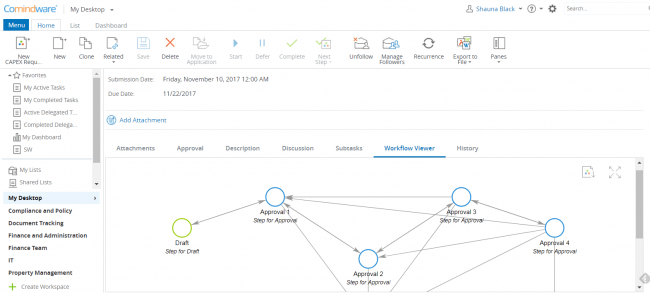Global competition is one of the challenges that modern businesses have to deal with. Also, they have to find ways to reduce their overheads while creating new products and services. As business processes evolve daily, organizations must search for ways to solve their challenges. One of the best solutions to use is workflow technology. It consists of software and methods that could improve the way business processes are captured, re-engineered, optimized and automated. Workflow is a concept that describes how processes in manufacturing divide work activities into distinct roles, tasks, procedures, and rules.
Key Benefits of Workflow Technology
In the past, humans performed and overseen the processes. Today, however, information technology has automated the workflow. Now there are computer programs that work and enforce rules and regulations. That’s why businesses should upgrade their workflow architecture by introducing modern workflow management tools. These tools have the following benefits:
- Promotes organizational change – Workflow management tools build tasks, roles, steps and rules into the organizational system. Hence, less human involvement is needed to manage the business processes. Furthermore, these tools make communication more efficient through document sharing, notifications, and a better understanding of the process. This can promote teamwork across business departments and among team members. Workflow management systems add cohesion to groups of people with diverse skills and experiences.
- Encourages the business process reengineering – Workflow systems cause organizations to re-evaluate and re-define their business processes. After the analysis, each process is improved before the workflow architecture is laid down. This is done to avoid embedding bad practices. Business reengineering reduces processing time, improves the quality and value of products or services and increases flexibility. As long as the implemented workflow management system receives firm support, it will enhance access to information.
- A clear-cut definition of the business processes – First, get a workflow service to help you with the implementation process. If they have an effective workflow coordination tool, you will no longer feel confused about your business process. It will provide either a textual or graphical method of defining each process. Every activity will be associated with either a human being or a computer application. Then, rules will be created to establish how each activity will progress across the workflow. As well, controls will be laid down to govern each activity. Finally, the defined process will be initiated and the person or computer application scheduled to complete each task will get engaged.
Even more, every task you are engaged in will be advanced with a graphic view of the whole workflow, its history, related attachments, discussions, subtasks, and more. Here is, for example, how task window looks like in a cloud-based workflow management software by CMW Lab:
- Allows workflow simulation, proper decision making and document routing – Workflow technology allows the use of tools that could simulate or make prototypes or pilot versions of a given workflow. This simplifies workflow trials and tests to be done quickly before the production phase. As for decision-making and the creation of rules, a workflow management system can help a lot. It can allow you to formulate rules for each step to determine how information is going to be processed, routed, tracked and regulated. For instance, email notifications may be generated once a given milestone is met. Lastly, this can introduce document routing to the system. For instance, the system might pass a file by attaching and passing it electronically so that people could individually comment on it.
The above four are not the only advantages provided by a properly implemented workflow technology system. The system can add instruments of data viewing and manipulation. These include GIS systems, word processors, document tracking software and spreadsheets. These let workers create, edit and view data and documentation with ease. The introduction of work lists allows every employee to identify the tasks they should do now and when they should finish it. Depending on the system being implemented, workers can know their workload in advance and tell the amount of time each step would take to complete and know when different tasks will reach their work desk. Some tools support remote workers via a web interface.
Selecting and Implementing a Workflow Management System- There are factors that should guide you through the selection and implementation process.
- First, you should focus on your business objectives. Study your organization to determine the goals you would like to meet via the assistance of the new workflow architecture tools.
- Then, select only the projects that support your goals. Ensure that those projects are well understood to make the initial implementation phase as smooth as possible.
- It is also important to gain the support and approval of the management. This is the only way you can be sure of the top management’s backup during the planning, implementation and refining phases. It is imperative to obtain subordinate staff support too. If the junior staffs are resistant to change, you might have to force them to commit. Otherwise, the process will get harder or fail. Assure your employees that they will be trained on the use of the new system. Additionally, convince them about the benefits of the work system, such as how it could automate routine tasks and free up their time.
- It will definitely be wise to utilize some metrics: length of the work list queues, the amount of errors, possible revenue generation, and length of cycle and labor hours needed to complete the process.
- Last but not least, aim to integrate the workflow system with your current system. So, you need to implement the software in phases.
Which is the Best Workflow Service?
After learning all about the benefits of a workflow management system, now you might want to know where to start. The starting point is just the selection of the best service. As there are many providers of workflow software, you could easily feel confused. That’s why we want to recommend a product we personally recognize and support. This is none other than CMW Tracker.
This software is designed for non-technical users who want to model, run and edit their workflows with ease. You can actually use this software the first time you buy it. It is idiot-proof and comprehensive in that it provides you with the CMW Workflow Builder, CMW Web Forms, Mobile platform support and Cloud-based Workflow Automation. Here is how workflow building interface looks like:
If you want to modify workflows, you could just use the low-code application. Whether you want to run processes parallel to each other or in a sequence, you could use the CMW Tracker workflow service to coordinate your business process.

